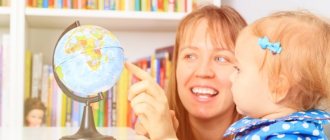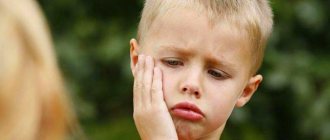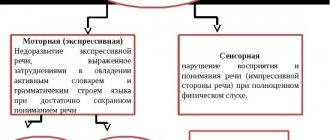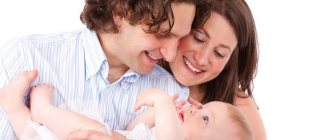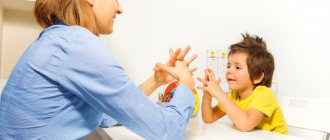Issues of differential diagnosis
In clinical practice, diagnosing RDA, especially in the first years of a child’s life, often presents significant difficulties, since this dysontogeny in its individual clinical and psychological components has much in common with other anomalies of mental development in children. As indicated, this is due to the similarity of a number of “age-related” symptoms and the possible commonality of other pathogenetic mechanisms of abnormal development.
As our observations have shown, in an early age of a child, RDA most often has to be differentiated from developmental anomalies such as neuropathy, mental development disorders with some residual organic brain damage, mental retardation, speech underdevelopment, deafness, and cerebral palsy.
Often significant difficulties are presented by differential diagnosis with neuropathy, the clinical manifestations of which are caused by congenital or early acquired neurovegetative lability (G. E. Sukhareva, 1955, etc.). P. B. Gannushkin (1928), as is known, classified this developmental anomaly as a group of asthenic psychopathies. Children with neuropathy, as well as autistic children of groups II and IV (hereinafter, the classification of O.S. Nikolskaya 1985-87 is used), have reduced physical, motor and mental tone, hypersensitivity and often associated increased sensitivity to the assessment of their behavior, inhibition, timidity, poor tolerance to changes in environment, selectivity in contacts. In this way they are often similar to autistic children. The similarity is aggravated by the similarity of interests (to nature, poetry, melodic music, etc.). With neuropathy, mood swings are often observed - sometimes moodiness and irritability, sometimes lethargy and apathy, seemingly unmotivated, as is often the case with RDA, but in fact due to weather lability, sleep disturbances, digestion, exposure to heat, and stuffiness. Increased reflex excitability sometimes causes difficulty sucking, swallowing, and fear of solid food.
These disorders are especially typical for the first years of life, when the vegetative sphere is normally characterized by significant instability. Motor stereotypes are also common in children with neuropathy. These children also have an asthenic body type and a tendency to allergies.
However, the manifestations of autonomic lability in neuropathy are more varied than in RDA. In infancy, regurgitation, fountain vomiting, unmotivated low-grade fever - a long temperature “tail” after infection - etc. are observed, which are not very typical for RDA. Children with neuropathy strive for contact not only with adults, but also with peers, if they do not have a negative attitude or aggression. Their fears are exaggerated (“overvalued”), but always adequate (fear of being alone, the dark, steep stairs, drunks, dogs, etc.) and relevant for the given moment. The motor stereotypies observed in them are often obsessive tics, reflecting in their clinical structure the cause that caused them (frequent blinking after conjunctivitis or a speck in the eye, twitching of the nose after rhinitis, etc.), and not the strange, grotesque movements of children with RDA. Their frequent negative reaction to a change in situation is also psychologically “understandable” - this, as a rule, happens with objectively negative changes in the environment. And vice versa, a new, but objectively comfortable, calm environment (moving to the country, to the sea, pleasant acquaintances, etc.) evoke a positive reaction in a neurotic child. Children with neuropathy love affection. Unlike autistic children, they willingly imitate in play. Their speech is not characterized by scantiness typical of Group II RDA, speech in the infinitive, commenting, delayed echolalia, slurring and agrammatisms typical of Group IV RDA.
Often, if the history of an autistic child contains indications of the pathology of pregnancy and childbirth, the neurological status includes signs of hydrocephalus, scattered organic signs, single convulsive episodes, and also if manifestations of RDA arise or become more noticeable after an infection, intoxication or traumatic brain injury , it is necessary to differentiate with mental disorders due to residual effects of organic failure of the central nervous system.
As can be seen from the above, the most common erroneous diagnoses relate specifically to the range of cerebral-organic pathology. The psychopathological similarity of these conditions with the manifestations of various variants of RDA consists in the presence of psychomotor excitability, impulsivity, instability of attention and mood, negativism, often aggressiveness, and pathology of drives. With hydrocephalus, there may be early development of speech with a tendency to cliches and verbosity.
But children with residual organic pathology of the central nervous system do not have autism; on the contrary, they are mostly annoying, intrusive, their psychomotor disinhibition, closely related to fatigue, is easily replaced by physical inactivity and complaints of headaches. Mental exhaustion plays an important role in activity disorders. Memory weakness is often noted. In the verbosity observed in children with hydrocephalus, there is a lot of imitation, a tendency to early reasoning, and dialogue. Mood fluctuations have an organic character of euphoria or dysphoria, and in the subacute period after infection - dysthymia with weakness, tearfulness, and asthenic nature of emotional disorders. The realization of pathological drives is carried out against the background of subjectively positive affective charge, emotions of pleasure, in contrast to group III RDA, where the pathological drive is closely related to the fear experienced by the child. Children with organic damage to the central nervous system are not characterized by such speech features as neologisms, mannerisms of intonation, delayed echolalia, pretentious stereotypies, especially sensory ones.
When diagnosing RDA with a predominance of group III symptoms, difficulties may arise in distinguishing from heboid psychopathy - an anomaly in the formation of the personal sphere, in which social adaptation is hampered by the pathology of drives. Certain features of this developmental anomaly can be observed at an early age. Such a child, already at the age of 2, can show traits of cruelty, aggression towards neighbors and children, the desire to do things out of spite, on the sly. But unlike a child with RDA, he will be quite sociable. He will also be characterized by dialogic speech, devoid, however, of specifically autistic verbalization. His drives will not be so obviously fueled by numerous fears.
For defectology, the most relevant is the early differential diagnosis of RDA and mental retardation, mental retardation, anomalies in the development of speech, sensory and motor areas.
If a child with RDA has intellectual development disorders, the question of differentiation with mental retardation or severe mental retardation often arises.
In this case, the alternative “either/or” approach is not valid. On the one hand, in severe forms of RDA, especially complicated ones (either combined or possibly caused by cerebral-organic insufficiency), mental retardation can also develop. In addition, in unfavorable environmental conditions, the intellectual underdevelopment of an autistic child may be due to the aggravation of his early autistic self-isolation by social deprivation. With these two types of mental retardation, clinicians often talk about “oligophrenic plus.” Perhaps, such forms include RDA syndrome in children with a fragile x chromosome. The three boys we observed had a very pronounced focus, gross satiety, inert motor agitation that did not correspond to the severity of other autistic manifestations, and a euphoric tint of mood. These manifestations resembled organic frontal failure, similar to “frontal oligophrenia.” Two children also had dysplasias typical of fragile X syndrome: a large head, protruding ears, prognathism, a high arched palate, an elongated and flattened face with a protruding forehead and large chin, and hyperextension of the joints.
On the other hand, E. Kraepelin spoke about “autism of the poor” in severe forms of oligophrenia. The lack of intellectual prerequisites for contacts, insufficient perception and processing of signals from the outside can be replaced by autostimulatory swaying of the body, head impacts, and other motor stereotypies. They resemble the corresponding motor activity of children with group II RDA.
But there are often cases when raising the question of differential diagnosis of mental retardation or varying degrees of mental retardation with RDA is legitimate. These are those fairly numerous cases when the appearance of mental retardation or developmental delay is created not by true intellectual underdevelopment, but by the characteristics of the behavior and activities of an autistic child. As mentioned above, M. Reiser (1966) believes that such a diagnostic error may affect every tenth child diagnosed with mental retardation. Essentially, the main reason for misdiagnosis of mental retardation is the core autistic symptom - the very lack of interaction with others.
Children of the first, most severe variant of RDA, already in the first year of life, are often regarded as suffering from oligophrenia due to the lack of an animation complex, a response to a smile, a reaction to a person in general, isolation of the mother and other loved ones, a weak reaction to discomfort and everything around them, lack of expression of desires or displeasure. After a year, severe mental retardation is imitated by the lack of speech, play, self-care skills, and “field” behavior.
But the difference between such an autistic child and a child with severe mental retardation is precisely in a much greater detachment from the environment and lack of eye contact. A child with mental retardation has eye contact, vital needs (for food, warmth) are quite pronounced, there is no such reaction to changes in the environment, but orientation in space is worse. There is a big difference in motor skills: with mental retardation - adynamia or constant fussiness, monotonous motor disinhibition; in group I RDA - the above-described plasticity of movements in involuntary activities.
In group II autistic children, the erroneous diagnosis of mental retardation or severe mental retardation is also usually due to their impairments in adequate interaction with others. Here, the difficulties of attracting their attention to the desired object or phenomenon, the difficulty of teaching even simple everyday skills, basic self-care, the monotonous manipulative nature of the game, the lack of development of speech, and the delay in the development of motor skills come to the fore. BUT mental retardation will not be characterized by the above-mentioned speech features of group II autistic children (original intonation, neologisms, delayed echolalia), interest in the sign. Violations of contacts with the environment in mental retardation will be expressed significantly less than the level of intellectual underdevelopment; at the same time, attachment to the mother will not reach an extreme degree, as in autistic symbiosis, fears will be much more adequate - fear of specific, to a certain extent, truly dangerous phenomena and objects (darkness, stairs, etc.).
Autistic children of group III, who have good speech, a tendency to fantasize, and sufficient orientation and skills, usually do not require differentiation from mental retardation.
Incorrect diagnosis of mental retardation, and more often mental retardation in autistic children of group IV can be facilitated by their passivity, lack of initiative, frequent lack of expression of interests, weak reaction to the environment, poverty of speech, and delay in the development of fine motor skills. But when establishing contacts with such a child, as a rule, a sufficient fullness of his inner world is revealed, often the presence of intellectual interests, a certain emotional sensitivity, and a large difference in intellectual productivity in his usual environment and outside it.
Particularly indicative is the differential diagnosis of groups II and IV of RDA and mental retardation when analyzing the dynamics of a child’s mental development during the 1st-2nd year of life. As mentioned, in autistic children, early mental development often occurs in a special order: speech and the prerequisites for cognitive processes are formed earlier, and the motor sphere is formed later. Gnosis matures earlier than praxis: by the age of two, when these children, as a rule, do not have self-service skills, they often distinguish colors and their shades, differentiate figures of various shapes, outlines of plants, show countries on a geographical map, etc. At this age their intellectual interests are often more pronounced than those of healthy children. With mental retardation of cerebral-organic origin (if it is not accompanied by the phenomena of cerebral palsy), there are inverse relationships: with a delay in the formation of all skills, the motor sphere, as a rule, develops faster than the grossly delayed intellectual one.
Finally, a somatic examination also has differential diagnostic significance. Children with RDA are more characterized by a general asthenic appearance and subtle facial features; Children with oligophrenia are more likely to have organic dysplasia of the head and trunk.
Autism in children of group I, who have a regressive nature of dysontogenesis and severe disorders occur after exogeny, sometimes has to be differentiated from organic dementia.
The similarity of these developmental anomalies is the collapse of purposeful activity, loss of speech, its replacement with inarticulate sounds, destruction of skills with replacement by severe motor stereotypies. However, with organic dementia there are no such gross disturbances in contacts; vital needs can even be intensified to the level of drives (gluttony, aggression, irresistible severe self-harm). The breakdown of speech is of the organic nature of early aphasia, while with this autistic variant, mutism is observed, which can sometimes unexpectedly “break through” a whole phrase. Motor stereotypies are more similar to primitive perseveratory actions. The appearance of a number of neurological signs in organic dementia is of great differential diagnostic importance.
The question of distinguishing RDA from speech pathology - sensory and motor alalia, dysarthria - arises in those fairly frequent cases when an autistic child does not seem to understand the speech of others, does not follow verbal instructions, often does not speak or almost does not speak himself, and slurs his words. Such difficulties usually arise with autistic children of groups I and IV.
However, in children with primary speech pathology, nonverbal communications are preserved: sign language; adequate facial expressions; intense, intent gaze into the interlocutor’s face; exclamations, the purpose of which is to attract the attention of others.
With RDA, communication disruptions are deeper. As mentioned, an autistic child for the most part does not even look into the eyes of the interlocutor, there is no pointing gesture. He often takes an adult’s hand without asking, leads him to the right place and places his hand on the necessary object. In a child with RDA, the reaction to speech addressed to him often depends on the situation: if it is necessary to follow an instruction, its understanding seems to suffer; Poor vocabulary, a tendency towards stereotypical speech cliches, and pronunciation problems are noted. In an affectively saturated situation, even a muted child with RDA can often “understand” a fairly complex phrase, say a word in a loud, clear voice, and correctly pronounce complex sound combinations.
The special nature of the speech of children with group IV RDA (quiet voice, slurring, unclear pronunciation), associated with their lack of communication, low muscle and mental tone, and sometimes the special scantiness of speech (in children of group II) can be regarded as phenomena of true dysarthria. However, in a state of emotional upsurge, in autistic play, when reading favorite poems, the speech of a child with RDA becomes clearer, smoother and louder. With little use of speech, an understanding of poetry and prose is often noted. Differential diagnostics with primary speech disorders also include such specific features of autistic speech as the above-mentioned uniqueness of intonation and the presence of echolalia. It is characteristic that these disorders are significantly reduced in the process of psychological and pedagogical correction and are resistant to speech therapy intervention.
In some cases, there is a need to differentiate between RDA and deafness. An autistic child in the first two years of life is sometimes suspected of being deaf, since he may not respond to a call or turn towards the source of the sound. In these cases, objective audiometric data are important. But there are also clinical and psychological differences based on the main disorders in RDA: in a situation that is affectively significant, an autistic child often reacts even to a quiet voice, calms down at the sounds of his favorite music and, conversely, becomes anxious and leaves when a vacuum cleaner or electric razor is turned on, gets scared other sounds, may cry if shouted at. As indicated, many children with RDA are characterized by a love of music. Not yet able to read, by some signs they can clearly distinguish outwardly similar records from each other. And at the same time, an autistic child does not look at the lips of the interlocutor, does not seek eye contact in order to understand the adult’s speech, as a deaf child does.
Often in clinical practice, and especially in young children, the question arises about the differential diagnosis of RDA and cerebral palsy (CP). The need for such differentiation arises because in the clinical picture of RDA, a significant place belongs to movement disorders, and in the psychopathological structure of cerebral palsy - to various autistic (usually pseudo-autistic) phenomena or secondary autism, situationally determined.
It is possible that movement disorders and autistic manifestations in RDA and cerebral palsy have some similar pathogenesis links, which complicates the distinction between these dysontogenetic forms. Moreover, the most severe forms of RDA, where there are also phenomena of organic failure of the central nervous system, may include true cerebral palsy syndrome, and cerebral palsy can be combined with a number of genetically determined manifestations of RDA. In these cases, we will talk about differentiating the main and additional syndromes in the holistic picture of this developmental anomaly. Movement disorders in both developmental anomalies will manifest themselves in disturbances in tone, rhythm and expressiveness of movements, underdevelopment of synchronous movements of the arms and legs when walking, disruption of the formation of expressive movements, primarily facial movements, rich in meaning and thus close to speech. Motor disorders characteristic of RDA and cerebral palsy also include a violation of the “kinetic melody” of movements (A. R. Luria, 1962) - their jerkiness and disautomation. The strength and accuracy of movements will also suffer in both RDA and cerebral palsy and thereby delay the formation of objective actions.
However, even in a young autistic child, affectively meaningful actions can be quite complex. With cerebral palsy, difficulties increase as the motor task becomes more complex, and the affective attitude to the task not only does not facilitate, but sometimes complicates the performance of movements due to increased spasticity, the occurrence of tonic muscle spasms and hyperkinesis. Dysarthric disorders are characteristic of cerebral palsy due to defects in the articulatory apparatus itself. With RDA, they will be imitated by slurred speech due to the autistic child’s lack of communication and lack of psychological attitude toward the interlocutor. Unlike a child with cerebral palsy, an autistic child can speak clearly and clearly in situations that are emotionally significant for him. The same patterns emerge in the assessment of other aspects of speech: children with severe forms of cerebral palsy are characterized by persistent disturbances in sound pronunciation, their combination with disturbances in swallowing and breathing; in children with RDA, mutism caused by fear of communication, a tendency to neologisms, inversion of pronouns, and a large difference in the manifestations of affectively significant or indifferent speech are more common.
In children with both cerebral palsy and RDA, the formation of orientation in space suffers: in cerebral palsy - from violations of spatial gnosis, movement disorders (difficulty turning the head, approaching an object of interest, limited field of vision due to disorders of the motor apparatus of the eyes, insufficiency of statokinetic reflexes ). With RDA, violations of orienting activity are more associated with a lack of voluntary attention, fear of the environment, weak interest in its development, emotional fixation on individual, objectively insignificant details, which for such a child determine the entire affective meaning of the situation. And at the same time, some children with RDA, even seemingly detached from their surroundings, often demonstrate good orientation in the space of the house and street.
In violations of objective actions in cerebral palsy, the role of underdevelopment of motor functions is obvious, in RDA - unevenness due to lack of focus on communicative actions and, conversely, often sufficient coordination of movements in performing a small range of actions that have a positive affective significance for the child. These patterns are especially evident in gaming activities. In children with cerebral palsy, its technical side suffers more, associated with deficits in motor skills and spatial synthesis. Due to an organic delay in general mental development, their play is characterized by inertia, monotony, and a lack of creativity, initiative, and independence. In children with RDA, the level of play largely depends on whether it is spontaneous, affectively significant, or given from the outside, subjectively indifferent.
The information deficit that exists in both children with cerebral palsy is caused by primary motor difficulties, disturbances of spatial gnosis, and defects in the sensory sphere; with RDA, a significant role is played by disturbances in the arbitrariness of perception and concentration, and fear of the environment.
Cerebral palsy, as well as RDA, is characterized by the vital physical dependence of the child on the mother: separation from her can lead to severe neuropsychic disorders. But in a child with cerebral palsy, these are rather “organic” phenomena: the occurrence of hypertension syndrome, increased hyperkinesis, salivation (E. M. Mastyukova, 1985). With RDA, as in other mental manifestations, the typical inconsistency of emotions, often the lack of visual contact even with loved ones, is more prominent. When separated from this person, an autistic child in the first years of life develops mental disorders of a different register: psychogenic stupor, mutism, fears. Children with RDA and cerebral palsy have a tendency to neurotic and neurosis-like phenomena: fears, fear of new things. However, if in cerebral palsy the nature of these disorders is more focused on the child’s physical helplessness and has a specific, situationally determined plot (fears of heights, depths, stairs, doors), then in RDA these disorders are outwardly much less adequate, often more diffuse (especially fear of any change in the situation , regime), sometimes significantly delayed in time from the fear that caused them.
A sense of inferiority is often inherent in both children, even at the age of two. As a rule, it is due to real inconsistency in the situation, but with cerebral palsy the child is more fixated on his physical weakness, with RDA, especially in children of group IV, more often on mental weakness.
There are certain similarities in the emotional sphere. Disorders of emotional development in cerebral palsy manifest themselves in a delay of the type of organic infantilism: insufficient differentiation of emotions, their certain inertia and monotony. Overprotection on the part of adults introduces traits of egocentrism into this organic structure of emotional underdevelopment and makes children passively dependent on those to whom such a child shows great affection.
Manifestations of autism itself can also be observed in cerebral palsy as secondary autism, hypercompensatory withdrawal (often reinforced by overprotection) from objective difficulties into the world of fantasy. Other hypercompensatory formations may be similar to RDA, especially group II: catatonic-like affective discharges, rocking as manifestations of autostimulation (Riebl, 1962). These conditions are observed especially often during hospitalization (E.M. Mastyukova, 1972). In children with cerebral palsy, the formation of pronounced mental retardation, similar to the manifestations of group IV RDA, is often observed. These formations differ from similar manifestations in RDA in their “understandability”, close chronological connection with real difficulties, accompanying phenomena of cerebrastia, and the absence of pretentiousness and mannerisms typical of RDA.
The supporting distinctive signs appear more clearly in a comparative analysis of the dynamics of the neuropsychic development of a child in the first years of life. What RDA and cerebral palsy have in common is a delay in the formation of the motor sphere. But the early formation of speech, which is quite typical for many children with RDA, is uncharacteristic for children with cerebral palsy, as well as other signs of dissociative ontogenesis common for RDA - a combination of opposite tendencies: fearfulness and lack of a “sense of edge” along with symbiotic attachment - detachment from neighbors, lack of eye contact, etc.
Naturally, the statics and dynamics of the neurological state, as well as the presence of persistent cerebrasthenic and encephalopathic disorders in cerebral palsy, are of paramount importance.
However, as already indicated, specific cases, especially with mild forms of cerebral palsy, can present significant diagnostic difficulties due to the possibility of secondary autism in cerebral palsy, as well as the possibility of dysontogenesis in cerebral palsy close to autistic, due to common pathogenetic mechanisms, most likely, disturbances in tone and instinctive spheres.
Causes of sensory alalia in children
Sensory alalia is associated with damage to those areas of the brain that respond to the analysis of sounds and speech. To be more precise, the posterior third of the left hemisphere: it is projected onto the area behind the ear.
The disease is caused by:
- Pathology during pregnancy - intrauterine hypoxia, infections, immune attack, drug use, bad habits, harmful working conditions, intoxication;
- Damage to the central nervous system during childbirth: rapid labor, narrow pelvis, obstetric care. The consequence is traumatic brain injury. And protracted labor, entanglement of the umbilical cord, oligohydramnios, premature loss of water causes damage to brain cells due to insufficient oxygen supply - hypoxia;
- Pathology in the postpartum period and the first years of life - injuries, space-occupying formations, inflammatory and infectious diseases of the brain and meninges, intoxication, toxic damage to brain cells due to infectious diseases.
Most often, several factors influence a child. The cortical part of the auditory-speech analyzer is affected, and the process of recognizing sound stimuli is disrupted. The child hears speech, but cannot grasp its meaning and content. That is, he has not developed phonemic processes and does not have the skill of holistic speech perception.
As a result, the excitation (impulse) is not transmitted along the chain to other analyzers: speech-visual, speech-motor. Thus, the baby hears speech, but cannot perceive it, analyze it, and therefore does not react to it in any way.
Treatment of sensory alalia in children
Treatment should be started as early as possible, before speech disorders are established and there are no severe psychological disorders. The role of family and loved ones is important: parents must understand the seriousness of the disease and be aware of the plan and stages of treatment. They are informed about the results of treatment at each stage. If necessary, a psychologist additionally works with them: for motivation, creating a favorable psychological background in the family.
Treatment is the same step-by-step process as diagnosis and consists of several parts:
- Medical methods of therapy include the prescription of drugs with nootropic effects, neuroprotectors, and vitamins that affect the central nervous system. Physiotherapeutic techniques (microcurrents, electrical stimulation, magnetic therapy), massage, therapeutic baths, and therapeutic exercises allow you to consolidate the effect of medications. How to treat sensory alalia depends on the individual characteristics of the baby and the course of his illness: there is no universal method or scheme;
- Classes with a speech therapist allow you to develop auditory perception and the ability to analyze speech. The specialist first works with logorrhea - verbosity, helps the child concentrate and maintain attention, teaches the skills of joint games and other team activities. The baby learns to distinguish non-speech sounds, then correlate sounds and short words with objects and actions. It is important that during the lessons the teacher clearly, understandably and briefly formulate the tasks and explain the material in the same way. Literacy training is of greater importance: the development of the visual analyzer facilitates the understanding of speech;
- Psychological assistance consists of developing thinking, memory, attention, and cognitive abilities. The specialist teaches the child skills to control emotions and corrects behavior. In a word, it helps him socialize.
Therapy for sensory alalia is usually long-term, continuous, lasting up to 4 years. After recovery, the child is observed. It is recommended that kindergarten and school continue classes with a speech therapist to prevent relapses and consolidate the results of treatment.
Signs of sensory alalia in children
The main symptom of sensory alalia is misunderstanding of addressed speech of varying degrees:
- Easy degree - children understand simple words that are often used in everyday life and in familiar situations. At the same time, if the same word is heard in an unfamiliar environment, they cease to understand it;
- The average degree is accompanied by more severe disorders. The number of words to which the child somehow reacts is minimal;
- In severe cases, children absolutely do not respond to speech and even to their name.
In this case, a characteristic symptom of sensory alalia is verbosity (logorrhea) - active speech, rich in sound combinations and interjections. Usually it is incomprehensible to others. Also, one of the signs of the disease is uncontrolled repetition of words (echolalia). But if you ask the baby to say this word, he will not be able to do this purposefully.
The child’s process of correlation between a phenomenon or object and the word that denotes it is disrupted. He places accents incorrectly, replaces letters, or skips them.
The voice is clear, hearing and intelligence are preserved. The baby quickly loses interest in activities and games, and has an unstable mood. In general, he is uncontrollable, impulsive, and even sometimes aggressive. As a result, it is difficult for him to build communication with others, and those around him avoid him.
